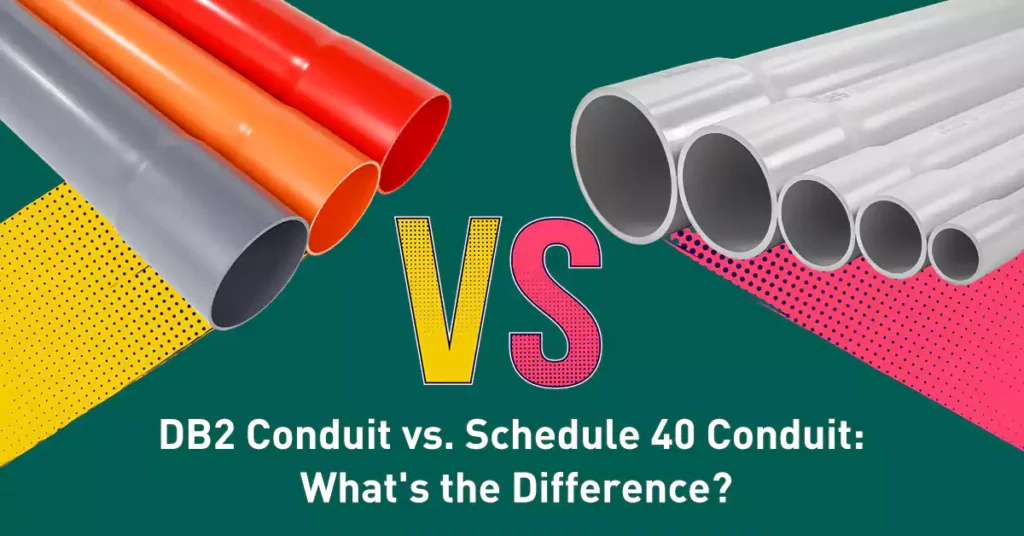
Tabla de contenido
En el mundo de los conductos eléctricos, los clientes suelen preguntar sobre las diferencias entre los conductos DB2 y los conductos Schedule 40. Si bien ambos se utilizan ampliamente para proteger el cableado eléctrico, cada uno presenta propiedades, normas de cumplimiento y ventajas de aplicación únicas. La elección del conducto adecuado depende de las necesidades específicas de cada proyecto, como los requisitos de resistencia, el entorno de instalación y el cumplimiento normativo. Este artículo ofrece una comparación exhaustiva de los conductos DB2 y Schedule 40, abarcando sus definiciones, normas, propiedades mecánicas, opciones de montaje y aplicaciones, para ayudarle a elegir el conducto ideal para su proyecto.
Conducto DB2, o Entierro directo 2 conductosEs un tipo de conducto rígido no metálico, diseñado específicamente para instalaciones subterráneas. Está diseñado para soportar presiones externas del suelo y resistir la corrosión ambiental. El conducto DB2 cumple con la norma canadiense CSA C22.2 N.º 211.1, que certifica su durabilidad para el enterramiento directo en diversas condiciones de suelo.
Conductos Schedule 40 Es un conducto rígido de PVC (cloruro de polivinilo) diseñado para instalaciones tanto superficiales como subterráneas. Conocido por su durabilidad, puede instalarse en espacios expuestos u ocultos y proporciona una excelente protección para el cableado eléctrico tanto en interiores como en exteriores. Aplicable a cables de baja tensión, se utiliza para la protección del cableado de sistemas de telefonía, internet, televisión y seguridad. El conducto cédula 40 debe cumplir con la norma UL651, que especifica los requisitos de rendimiento y seguridad para conductos plásticos.
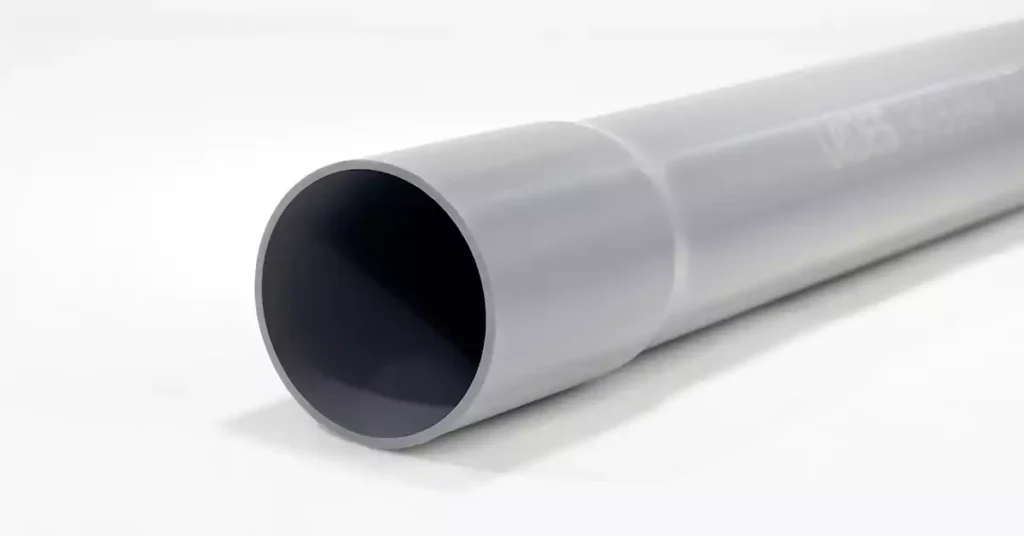
Conducto DB2: CSA C22.2 N.º 211.1, Esta norma establece pautas para el uso de entierro directo en aplicaciones subterráneas en Canadá.
Conducto de PVC Schedule 40: UL651, la norma regula los requisitos de rendimiento, durabilidad y seguridad de los conductos de PVC en EE. UU.
Estas normas garantizan que cada tipo de conducto cumpla con métricas de rendimiento mecánico y de seguridad específicas, lo que los convierte en opciones confiables para las aplicaciones previstas.
Tanto los conductos DB2 como los Schedule 40 deben cumplir con un conjunto de propiedades, tal como se describe en sus respectivos estándares. A continuación, se presentan algunas propiedades comunes requeridas:

Conducto Schedule 40
Según la norma UL651, los conductos de PVC rígido cédula 40 deben cumplir un requisito específico de resistencia a la tracción. Esta no debe ser inferior a 5000 psi (34,5 MPa) en muestras no envejecidas. Esta resistencia garantiza que el conducto pueda soportar tensiones significativas sin elongación ni rotura, lo que lo hace adecuado tanto para aplicaciones superficiales como subterráneas donde la exposición a variaciones ambientales, movimiento o manipulación pueda generar tensiones de tracción. En cualquier caso, la resistencia a la tracción del conducto no debe ser inferior a:
- a) 5000 psi (34,5 MN/m2) (3,45 kN/cm2) (3515 gf/mm2) para conductos de PVC rígido Schedule 40 y 80
- b) 4000 lbf/in2 (27,6 MN/m2 o 2,76 kN/cm2 o 2812 gf/mm2) para conductos de PVC rígido tipo A y EB
Para evaluar este requisito, se prueban tres muestras de conducto cédula 40 sin envejecer para determinar su resistencia a la tracción base. Estas muestras se envejecen, y la resistencia a la tracción promedio de las muestras envejecidas debe ser igual o superior a 95% de la resistencia a la tracción promedio de las muestras sin envejecer. Esta prueba de envejecimiento sigue procedimientos similares a los descritos en el Método de Ensayo Estándar para las Propiedades de Tracción de Plásticos (ASTM D 638), lo que garantiza que el conducto conserve su resistencia en diferentes condiciones.
Estas especificaciones hacen que el conducto Sch 40 sea una excelente opción para aplicaciones que requieren conductos duraderos y de alta resistencia, incluso en entornos donde las fluctuaciones de temperatura o la posible exposición a factores estresantes son más comunes.
Resistencia a la tracción del conducto DB2
Para los conductos DB2, utilizados principalmente en aplicaciones de enterramiento directo, la norma CSA C22.2 N.º 211.1 no define requisitos específicos de resistencia a la tracción. Dado que los conductos DBii se instalan bajo tierra, donde la temperatura se mantiene relativamente estable y protegidos de los elementos superficiales, están menos expuestos a factores de tensión que podrían requerir parámetros de referencia estrictos de resistencia a la tracción. Esta estabilidad en el entorno de instalación ayuda a minimizar los problemas de expansión y contracción térmica, lo que reduce la necesidad de un alto rendimiento de resistencia a la tracción en los conductos DB2.
Resistencia al impacto de conductos Schedule 40
Según la norma UL651 (Artículo 6.6, Tabla 6.2), los conductos de cédula 40 deben someterse a una prueba de impacto específica. Durante esta prueba, se deja caer sobre el conducto un peso de 9,1 kg (20 libras) desde una altura determinada, con forma de cilindro de 51 mm (2 pulgadas) de diámetro. Este requisito garantiza que los conductos de cédula 40 resistan impactos físicos, lo que los hace adecuados para instalaciones expuestas donde pueden producirse impactos accidentales, como en aplicaciones sobre el suelo.
Tamaño del comercio | Altura sobre el espécimen (Cédula 40) | |
pies | (metro) | |
1/2 | 2-1/2 | 0.762 |
3/4 | 4 | 1.22 |
1 | 5 | 1.52 |
1-1/4 | 6 | 1.83 |
1-1/2 | 7-1/2 | 2.29 |
2 | 9-1/2 | 2.90 |
2-1/2 | 10-1/2 | 3.20 |
3 – 6 | 11 | 3.35 |
Resistencia al impacto de los conductos DB2
Para el conducto DB2, la norma CSA C22.2 N.º 211.1 (cláusula 6.2) especifica un método de prueba de impacto diferente. El conducto DB2 debe soportar una energía de impacto de 61 julios a 23 °C (73,4 °F) y 34 julios a –18 °C (0 °F). Este método garantiza que el conducto DB2 mantenga su integridad a diferentes temperaturas, especialmente en condiciones de frío extremo, donde el material puede ser más frágil. Debido a su aplicación enterrada directa, la resistencia al impacto del conducto DB2 está optimizada para entornos subterráneos donde puede estar expuesto a fuerzas del suelo o de los equipos.
Si estás interesado en la sección de Resistencia al Impacto, puedes hacer clic aquí para leer Información sobre el rendimiento de resistencia al impacto de los conductos de PVC Escrito por nuestro equipo técnico.
Tipo de conducto | Método de prueba de impacto | Peso/Fuerza | Temperatura |
Conducto Schedule 40 | UL651, Artículo 6.6, Tabla 6.2 | 20 libras (9,1 kg) | 23,0 ± 2,0 ℃
|
Conducto DB2 | CSA C22.2 NO. 211.0, Cláusula 6.3.1, Método A | 1,36 kg ± 10 g 61 J a 23 ℃, 34 J a -18 ℃ | 23 ℃ y -18 ℃ |
La resistencia al aplastamiento es una propiedad fundamental para los conductos, ya que garantiza que puedan soportar presiones externas sin deformarse.
Resistencia al aplastamiento de conductos Schedule 40
Según la norma UL651 (Artículo 6.9), los conductos de cédula 40 se someten a una prueba de aplastamiento para evaluar su resistencia a la deformación. El conducto no debe aplanarse bajo la carga indicada en la tabla 6.3 hasta el punto de pandeo, y el eje menor medido dentro de cada muestra cargada no debe ser inferior al 70 % del diámetro interior de la muestra medido antes de la carga.
- Tasa de movimiento de las placas: La placa debe moverse hacia la otra a la velocidad de 1/2 ±1/8 de pulgada (10,0 ±2,5 mm) por minuto, hasta que se aplique la carga especificada en la Tabla 6.3 según lo indicado en el dial de la máquina.
La norma exige que el conducto Sch 40 mantenga su integridad estructural hasta un umbral específico, que simula condiciones reales en las que el conducto puede estar expuesto al peso o la presión de instalaciones sobre el suelo, como cargas de tráfico o maquinaria pesada. Esto garantiza que el conducto se mantenga funcional y seguro incluso en entornos donde pueda sufrir una compresión física significativa.
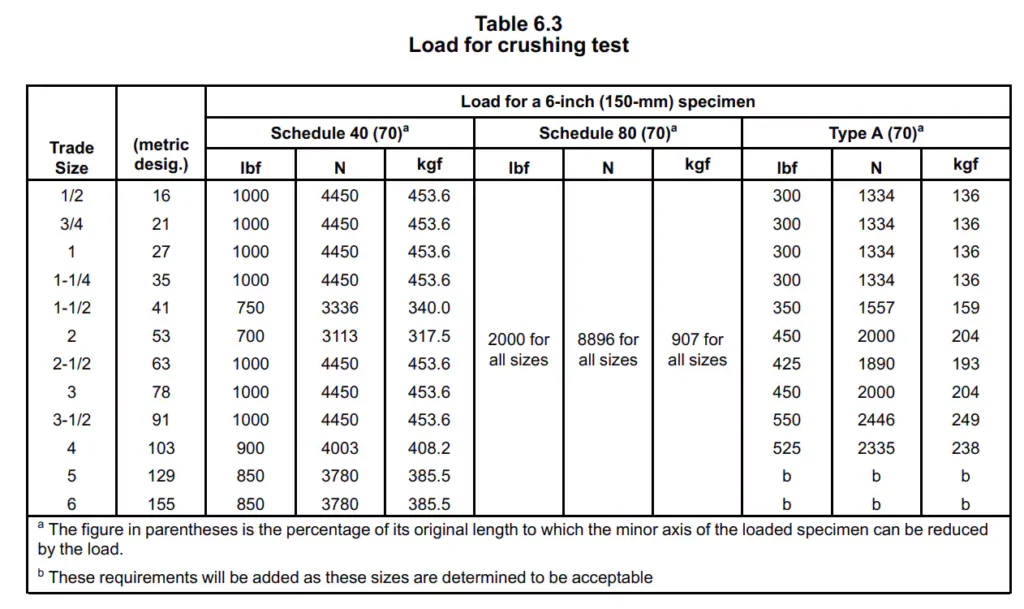
Resistencia al aplastamiento del conducto DB2
Para conductos DB2, la norma CSA C22.2 N.° 211.1 (Artículo 6.3) establece los requisitos específicos de resistencia al aplastamiento en aplicaciones de enterramiento directo. Exige que el porcentaje de disminución del diámetro durante y después de la recuperación sea... no excederá 10% en DB2, y no deberá exceder 5% después de la recuperación.
- Aplicación de carga: Se aplica gradualmente una masa de 90 kg (incluida la platina) y se mantiene durante 60 ± 5 segundos.
- Medición del diámetro bajo carga: Mientras se aplica la masa, se vuelve a medir el diámetro interior vertical.
- Medición de recuperación: Después de retirar la carga, el conducto se recupera durante 300 ± 20 segundos antes de que se mida nuevamente el diámetro.
- Cálculo de deformación: Se calcula la disminución porcentual del diámetro, tanto bajo carga como después de la recuperación, indicando la resistencia al aplastamiento del conducto.
Esta norma especifica que el conducto DBII debe soportar una carga específica por unidad de longitud para simular el peso del suelo u otros materiales que pueden ejercerse sobre el conducto al estar enterrado. La norma CSA está diseñada para garantizar que el conducto DB2 resista las tensiones específicas de las instalaciones enterradas, donde no solo está protegido de las cargas superficiales directas, sino que también soporta presiones prolongadas del suelo circundante.
Rigidez de conductos Schedule 40
Para los conductos de PVC cédula 40, la rigidez de la tubería se evalúa según la norma ASTM D 2412 (Método de prueba estándar para la determinación de las características de carga externa de tuberías de plástico mediante carga de placas paralelas). Los conductos cédula 40 utilizados en aplicaciones de perforación direccional deben cumplir con una Rigidez mínima de la tubería de 120 psi (827 kPa) con una deflexión de 10%Esto garantiza que el Schedule 40 mantenga la integridad estructural y resista la deformación bajo presión externa.
Rigidez del conducto DB2
El conducto DB2, probado también según la norma ASTM D 2412, tiene requisitos de rigidez más estrictos dada su aplicación de entierro directo:
- Conducto tipo EB1: Debe tener una rigidez de tubería mínima de 200 kPa con una deflexión de 5%.
- Conducto tipo DB2/ES2: Debe cumplir con un umbral más alto, con una rigidez de tubería mínima de 300 kPa con una deflexión de 5%.
Estos valores garantizan que los conductos DB2 resistan presiones subterráneas de manera más efectiva, brindando mayor resiliencia contra cargas de suelo y otras fuerzas ambientales típicas en aplicaciones de entierro.
Tipo de conducto | Rigidez mínima de la tubería | Porcentaje de deflexión | Método de prueba estándar |
Anexo 40 | 120 psi (827 kPa) | 10% | ASTM D 2412 |
Tipo DB2/ES2 | 300 kPa | 5% | ASTM D 2412 |
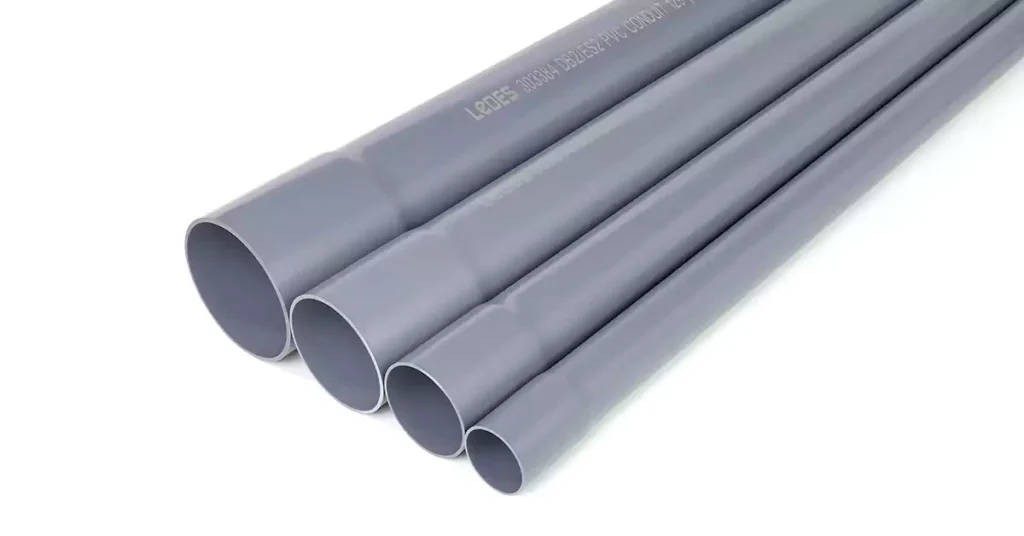
Conducto Schedule 40
Para los conductos de PVC Schedule 40, la resistencia a la luz solar es esencial para garantizar su durabilidad a largo plazo frente a la radiación UV. Según la norma UL651, se realizan pruebas de resistencia al impacto Izod para medir la resistencia del material a la exposición prolongada a la luz solar.
- Requisito de impacto inicial: Las muestras de barras no envejecidas mecanizadas a partir de conductos Schedule 40 o Schedule 80 deben alcanzar una Resistencia al impacto Izod promedio de al menos 0,5 ft-lbf/pulgada (27 J/m) de ancho de muesca. Esto garantiza que el conducto pueda soportar impactos mecánicos incluso antes de la exposición a los rayos UV.
- Prueba de exposición prolongada a la luz solar: Las muestras de conductos Schedule 40 se someten a acondicionamiento para 720, 1080 y potencialmente 1440 horas Para simular una exposición prolongada a la luz UV. Tras cada intervalo de tiempo, se mide la resistencia al impacto Izod promedio para garantizar el cumplimiento de los valores especificados en la Tabla 6.4 de la norma UL651. Esta prueba utiliza un proceso similar al de la norma ASTM D 256 (Método de prueba para determinar la resistencia al impacto de péndulo Izod de los plásticos), lo que garantiza que el material conserve su resistencia al impacto incluso tras una exposición prolongada a la luz solar. La prueba de 1440 horas es especialmente rigurosa, lo que garantiza su durabilidad en instalaciones exteriores prolongadas.
Conducto DB2
A diferencia del Schedule 40, el conducto DB2 está diseñado para aplicaciones de enterramiento directo, donde normalmente no está expuesto a la luz solar. Por lo tanto, el conducto DB2 no tiene requisitos específicos de resistencia a la luz solar según CSA C22.2 NO. 211.1, ya que su entorno subterráneo lo protege de la radiación UV, eliminando así la necesidad de realizar pruebas de luz solar.
Siempre existe un requisito de resistencia al fuego para los conductos eléctricos; para los conductos Schedule 40 y DB2, existen diferentes requisitos de inflamabilidad.
Consejos: El rendimiento de resistencia a la luz solar y clasificación de fuego es el rendimiento más importante para la durabilidad del conducto eléctrico, puede obtener información más profesional de esta publicación. Análisis de la luz solar y los rayos UV para conductos eléctricos..
Conducto Schedule 40
- UL651: De acuerdo con el artículo 6.11 de UL651, un conducto Schedule 40 no debe arder durante más de 5 segundos después de cualquiera de tres aplicaciones de llama de 60 segundos, y el conducto no debe ser capaz de encender materiales combustibles en su proximidad durante, entre o después de las tres aplicaciones de la llama de prueba.
- UL94: Además de los requisitos de inflamabilidad de la norma UL651, la mayoría de los clientes también exigen que el conducto cumpla con la clasificación V0 tras las pruebas de la norma UL94. La clasificación de inflamabilidad UL94 es un estándar desarrollado por Underwriters Laboratories (UL) para medir la probabilidad de ignición de un material plástico. A continuación, se presentan las clasificaciones de inflamabilidad incluidas en la norma UL94:
Clasificación UL94 | Orientación | Requisitos |
5VA | Vertical | La combustión se detiene dentro de los 60 segundos después de cinco aplicaciones de llama (cada aplicación de 5 segundos), no hay goteos de llama y las muestras no tienen ningún orificio de quemadura; |
5VB | Vertical | La combustión se detiene dentro de los 60 segundos después de cinco aplicaciones de llama (cada aplicación de 5 segundos), no hay goteos de llama y las muestras pueden tener un orificio quemado; |
V0 | Vertical | La combustión se detiene en 10 segundos después de dos aplicaciones de llama (cada 10 segundos de aplicación), no hay goteo de llama; |
Versión 1 | Vertical | Las correas se queman dentro de los 60 segundos después de dos aplicaciones de llama (cada 10 segundos de aplicación), sin goteos de llama; |
V2 | Vertical | La combustión se detiene a los 60 segundos después de dos aplicaciones de llama (cada aplicación de 10 segundos), se permiten gotas de llama; |
media pensión | Horizontal | La combustión se detiene antes de los 100 mm. |
Conducto DB2
El conducto DB2, diseñado principalmente para aplicaciones de entierro directo, cumple con los estándares de Canadá, que incluyen clasificaciones de inflamabilidad como FT4 y FT6:
Prueba de llama FT4
La certificación FT4 goza de gran prestigio debido a sus rigurosos requisitos de prueba. La prueba FT4 somete los cables a una llama de 70.000 BTU/hora en una configuración de bandeja vertical. El procedimiento de prueba es exigente:
- Configuración de prueba: Los cables se montan en una bandeja vertical y se exponen a una llama de 70.000 BTU/hora durante 20 minutos. Esta configuración simula el intenso calor al que podría estar expuesto un cable o conducto en incendios industriales reales.
- Criterios: Para que un cable o conducto supere la prueba FT4, el material carbonizado no debe extenderse más de 1,5 metros (5 pies) desde el borde inferior de la cara del quemador. Este requisito se especifica en la norma CSA C22.2 n.º 38 y es prácticamente idéntico a la prueba de llama IEEE 1202. Debido a los límites reducidos de altura de carbonización, la prueba FT4 se considera ligeramente más rigurosa que la prueba de bandeja vertical UL1685.
- Aplicaciones: La certificación FT4 es crucial para espacios industriales y comerciales donde la propagación vertical de llamas podría representar un peligro. Superar la prueba FT4 garantiza que el conducto limitará la propagación de las llamas, mejorando así la seguridad contra incendios en entornos con alta densidad de cableado.
Prueba de llama FT6
La certificación FT6, conocida como prueba de llama de túnel Steiner (similar a la NFPA 262 en EE. UU.), es aún más rigurosa y evalúa principalmente la propagación de la llama y la producción de humo en cámaras de tratamiento de aire. Esto es fundamental en sistemas de climatización (HVAC) y en cualquier entorno con aire circulante, donde la baja emisión de humo y la propagación limitada de la llama son esenciales.
- Configuración de prueba: La prueba utiliza un túnel Steiner de 7,6 metros (25 pies) equipado con conductos de admisión y escape para controlar el flujo de aire. Los cables o conductos se montan en una bandeja dentro del túnel, con dos quemadores circulares en el extremo de admisión. El metano se quema a un flujo de aire de 73,5 metros/min (240 pies/min) a través del túnel durante 20 minutos.
- Criterios: Para superar la prueba FT6, la distancia de propagación de la llama no debe superar los 1,52 metros (5 pies). Además, la prueba monitorea la densidad del humo, requiriendo que la densidad óptica máxima del humo no supere 0,5, con una densidad óptica promedio inferior a 0,15. Estos criterios garantizan que los materiales con clasificación FT6 tengan una excelente resistencia al fuego y una baja producción de humo, ideales para entornos sensibles donde se debe preservar la calidad del aire.
- Aplicaciones: Los materiales con certificación FT6 se utilizan en cámaras de aire, sistemas HVAC y otros espacios donde minimizar la propagación del humo y las llamas es esencial para la seguridad y la calidad del aire.
Accesorios para conductos DB2
Accesorios para conductos DB2 Están fabricados para ser compatibles con aplicaciones de enterramiento directo. Estos accesorios están diseñados para formar sellos herméticos, evitando la entrada de humedad y protegiendo el cableado eléctrico de elementos subterráneos.
Accesorios para conductos Schedule 40
Accesorios del programa 40 Ofrecen flexibilidad tanto en instalaciones superficiales como subterráneas. Incluyen codos, acoplamientos, adaptadores y cajas de conexiones que permiten adaptar el conducto a diversas configuraciones. Estos accesorios son fáciles de instalar y compatibles con la mayoría de las tuberías de conducto cédula 40.
Comparación de dimensiones de accesorios
Los accesorios de cemento solvente de uso común para ambos tipos de conductos, como acoplamientos, codos y curvas, ofrecen las mismas funciones, también pueden tener una apariencia similar, pero los requisitos de dimensiones son bastante diferentes, aquí tomamos los codos como ejemplo para tener una comparación de dimensiones:
Tamaño del comercio | Conducto Schedule 40 | Conducto DB2 | ||
Radio R (mm) | Longitud Ls (mm) | Radio R (mm) | Longitud Ls (mm) | |
1/2 | 100 | 38 | / | / |
3/4 | 114 | 38 | / | / |
1 | 146 | 48 | / | / |
1-1/4 | 184 | 50 | / | / |
1-1/2 | 210 | 50 | / | / |
2 | 241 | 50 | 241 | 38 |
2-1/2 | 267 | 76 | / | / |
3 | 330 | 79 | 330 | 38 |
3-1/2 | 380 | 83 | 381 | 44.5 |
4 | 400 | 86 | 406 | 50.5 |
4-1/2 | / | / | 508 | 57 |
5 | 600 | 92 | 610 | 63.5 |
6 | 760 | 95 | 762 | 82.5 |
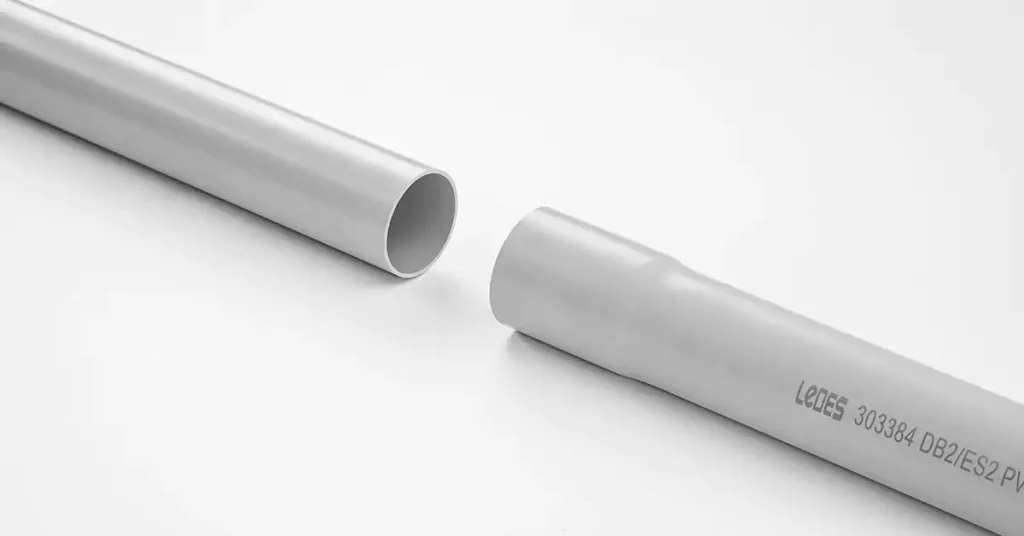
Aplicaciones de conducto DB2: Ideal para aplicaciones de enterramiento directo, el DB2 se utiliza comúnmente en proyectos de infraestructura subterránea, como líneas de servicios públicos, alumbrado público y obras públicas. Su resistencia a la corrosión y tolerancia a la presión lo hacen adecuado para lugares con condiciones de suelo variables.
Aplicaciones de conductos Schedule 40: El conducto cédula 40 se utiliza en instalaciones residenciales, comerciales e industriales, donde su versatilidad permite su instalación en paredes, techos y exteriores. Es adecuado para aplicaciones con exposición a la luz solar, lo que lo hace popular para sistemas de cableado de edificios.
Peso:
Conducto Schedule 40: El conducto Schedule 40 se fabrica con una pared más gruesa que el DB2, lo que le confiere mayor durabilidad y peso. Esta construcción permite su uso tanto en aplicaciones superficiales como expuestas. Gracias a sus paredes más gruesas, el conducto Schedule 40 es más pesado que el DB2, lo que lo hace más robusto, pero también más difícil de manipular en ciertas aplicaciones. Este peso adicional contribuye a su durabilidad y resistencia tanto en entornos subterráneos como expuestos.
Conducto DB2: El conducto DB2 está diseñado para aplicaciones de entierro directo, donde no requiere el mismo nivel de espesor estructural que el Schedule 40. Con paredes más delgadas, el conducto DB2 es más liviano que el Schedule 40, lo que facilita su manejo en proyectos de instalación subterránea donde el peso y el manejo del material son consideraciones críticas.
Espesor de la pared y dimensiones del zócalo
Para comprender mejor sus requisitos de dimensión, aquí compararemos algunos datos de dimensión importantes de ellos:
de Size | Conducto Schedule 40 | Conducto DB2 | ||||
Máx. OD | ID mín. promedio | T mínima | Máx. OD | ID mín. promedio | T mínima | |
1/2 | 21.54 | 14.68 | 2.77 | / | / | / |
3/4 | 26.92 | 19.81 | 2.87 | / | / | / |
1 | 33.66 | 25.50 | 3.38 | / | / | / |
1-1/4 | 42.47 | 33.90 | 3.56 | / | / | / |
1-1/2 | 48.56 | 39.72 | 3.68 | / | / | / |
2 | 60.63 | 51.33 | 3.91 | 57.30 | 50.80 | 1.78 |
2-1/2 | 73.41 | 61.31 | 5.16 | / | / | / |
3 | 89.28 | 76.40 | 5.49 | 82.75 | 76.20 | 2.03 |
3-1/2 | 102.87 | 88.54 | 5.74 | 95.00 | 88.40 | 2.29 |
4 | 115.57 | 100.60 | 6.02 | 107.30 | 100.10 | 2.67 |
4-1/2 | / | / | / | 121.70 | 114.30 | 2.79 |
5 | 142.57 | 126.36 | 6.55 | 134.85 | 126.35 | 3.81 |
6 | 169.54 | 152.04 | 7.11 | 159.65 | 149.75 | 3.94 |
Tamaño del comercio | Anexo 40 | Conducto DB2 | ||||
En la entrada | En el fondo | Profundidad mínima del zócalo (mm) | En la entrada | En el fondo | Profundidad mínima del zócalo (mm) | |
1/2 | 21.64 | 21.23 | 16.56 | / | / | / |
3/4 | 27.03 | 26.57 | 18.26 | / | / | / |
1 | 33.78 | 33.27 | 22.22 | / | / | / |
1-1/4 | 42.60 | 42.04 | 23.83 | / | / | / |
1-1/2 | 48.72 | 48.11 | 26.97 | / | / | / |
2 | 60.78 | 60.17 | 28.58 | 57.53 | 57.02 | 18.92 |
2-1/2 | 73.41 | 72.85 | 37.31 | / | / | / |
3 | 89.28 | 88.70 | 40.49 | 83.08 | 82.42 | 37.97 |
3-1/2 | 101.98 | 101.40 | 42.85 | 95.38 | 94.51 | 38.10 |
4 | 114.68 | 114.07 | 44.45 | 107.57 | 106.91 | 43.94 |
4-1/2 | / | / | / | 122.43 | 121.06 | 50.80 |
5 | 142.06 | 141.05 | 49.20 | 135.38 | 134.47 | 62.99 |
6 | 169.11 | 168.00 | 53.98 | 160.15 | 159.26 | 74.93 |
Existen diferentes requisitos de marcado para los conductos Schedule 40 y los conductos DB2 según las normas UL y CSA. A continuación, se presentan los requisitos de marcado de CSA C22.2 No.211.1 y UL651:
CSA
Cada longitud estándar de conducto y cada codo y curva se marcarán de manera legible y duradera para mostrar la
- a) nombre del fabricante, marca registrada u otro símbolo de identificación reconocido;
- b) denominación del producto;
- c) tamaño del comercio;
- d) fecha de fabricación o código del fabricante; y
- e) Número de norma CSA.
Cada accesorio deberá estar marcado de forma legible y duradera en su superficie exterior para mostrar la
- a) nombre del fabricante, marca registrada u otro símbolo de identificación reconocido;
- b) la designación del producto; y
- c) tamaño del comercio.
UL
8.1.3 El marcado del producto, envase o etiqueta deberá incluir:
- a) La frase “conducto rígido de PVC”,
- b) El tamaño comercial del producto conducto,
- c) El nombre o marca del fabricante o cualquier otro signo distintivo mediante el cual
La organización responsable del producto puede ser fácilmente identificada y
- d) La fecha u otro período de datación de fabricación que no exceda de tres meses consecutivos.
Para un codo, la fecha de fabricación será la fecha en que:
1) El conducto se extruye cuando tanto la extrusión como la flexión ocurren en el mismo lugar o
2) Se formó el codo, donde el conducto se extruye en una ubicación diferente.
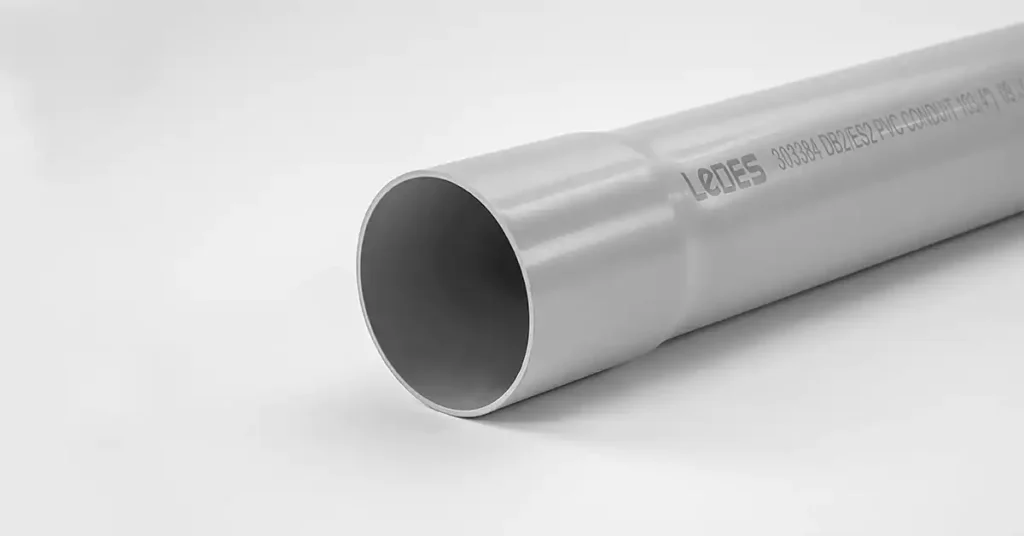
Al elegir entre conductos DB2 y cédula 40, considere factores como las condiciones ambientales, el presupuesto, el tipo de instalación y los requisitos normativos. El conducto DB2 es más adecuado para aplicaciones subterráneas y de servicio pesado que requieren mayor resistencia y protección ambiental. La cédula 40 es versátil y económica, ideal para uso general.
- Requisitos del proyecto
El primer paso es evaluar las necesidades generales de su proyecto. Las aplicaciones sobre el suelo generalmente son adecuadas para el conducto Cédula 40 debido a sus robustas propiedades estructurales y al cumplimiento de los requisitos de exposición a la intemperie. Sin embargo, si su proyecto incluye aplicaciones de enterramiento directo, el conducto DB2 es una mejor opción. El DB2 está diseñado específicamente para instalaciones subterráneas y cuenta con características optimizadas para las condiciones del suelo y la estabilidad térmica.
- Consideraciones ambientales
El entorno donde se instalará el conducto influye considerablemente en la elección. Por ejemplo, el conducto Cédula 40 posee propiedades de resistencia a los rayos UV, lo que lo hace adecuado para instalaciones exteriores sobre el suelo, donde puede estar expuesto a la luz solar. El conducto DB2, en cambio, no requiere resistencia a los rayos UV, ya que está diseñado para ser enterrado directamente. Al elegir el material, considere factores como las temperaturas extremas, la exposición a productos químicos y la exposición a los rayos UV.
- Cumplimiento del código
Garantizar el cumplimiento de la normativa es esencial para mantener los estándares de seguridad y calidad. El conducto cédula 40 cumple con la norma UL651, mientras que el conducto DB2 cumple con la norma CSA C22.2 n.º 211.1. Estas normas describen los requisitos específicos para cada tipo de conducto, incluyendo la inflamabilidad, la resistencia al impacto y la resistencia al aplastamiento. Elija un conducto que cumpla con los códigos de construcción locales y nacionales para la ubicación de su proyecto.
- Costo
El conducto DB2 suele ser más económico debido a su menor peso y a su construcción de paredes más delgadas, lo que lo convierte en una opción rentable para instalaciones subterráneas. El conducto cédula 40, al ser más robusto, suele ser más costoso. Al presupuestar los materiales, es importante considerar el equilibrio entre los costos iniciales y los requisitos de durabilidad a largo plazo del proyecto.
- Costo de instalación
El conducto cédula 40 es más pesado y puede requerir más mano de obra y recursos para su instalación, especialmente en instalaciones sobre el suelo donde se necesitan soportes. El conducto DB2, al ser más ligero y estar optimizado para enterramiento, suele ser más fácil de instalar bajo tierra, lo que puede reducir los costos de instalación. Evaluar los costos de instalación según el peso del conducto, la accesibilidad y los requisitos del equipo puede ayudar a determinar la mejor opción para proyectos con presupuesto ajustado.
- Variedad
El cédula 40 ofrece una gama más amplia de accesorios y tamaños, lo que lo hace versátil para diversas aplicaciones y configuraciones. Si su proyecto requiere flexibilidad en el diámetro del conducto, los accesorios o las opciones de accesorios, el cédula 40 puede ofrecer más variedad para satisfacer las necesidades específicas del diseño. El conducto DB2 generalmente tiene opciones de tamaño y accesorios más limitadas, ya que suele estar optimizado para una instalación subterránea sencilla.
- Consultando con profesionales
Consultar con profesionales del sector o proveedores de conductos puede proporcionar información valiosa adaptada a las necesidades específicas de su proyecto. Los profesionales pueden evaluar las especificaciones de su proyecto y las condiciones ambientales para recomendar el tipo de conducto más adecuado. Su experiencia también puede ayudarle a ajustarse al presupuesto, garantizando al mismo tiempo el cumplimiento normativo y un rendimiento óptimo.
En resumen, tanto los conductos DB2 como los de cédula 40 ofrecen una protección fiable para el cableado eléctrico, pero están optimizados para diferentes entornos y requisitos de proyecto. El conducto DB2 está diseñado para una mayor durabilidad en aplicaciones subterráneas de enterramiento directo, con mayor espesor de pared y una robusta resistencia al aplastamiento. Por otro lado, el conducto de cédula 40 ofrece versatilidad, asequibilidad y facilidad de instalación para aplicaciones de uso general.
En Ledes, nos comprometemos a ofrecer soluciones de conductos certificados y de alta calidad que cumplen con las normas CSA y UL, incluyendo opciones en los tipos DB2 y Schedule 40. Nuestros productos se someten a rigurosas pruebas para garantizar que cumplan con los estándares de la industria en cuanto a durabilidad, seguridad y rendimiento, lo que los convierte en una opción confiable para contratistas e ingenieros en diversas aplicaciones.
La elección del conducto adecuado depende de comprender las necesidades específicas de cada proyecto y en Ledes estamos aquí para ayudar a nuestros clientes a encontrar la solución óptima para sus necesidades de infraestructura eléctrica.



